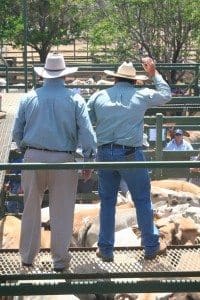THE Eastern Young Cattle Indicator has continued to descend into alarming territory, approaching lows not seen since the end of the last major drought episode in April 2015.
 Weighed down by relentless drought across eastern Australia and few encouraging signs of a decent late summer seasonal break across large parts of NSW and Queensland, the EYCI yesterday fell below 450c/kg carcase weight for the first time since a single day in April last year, and prior to that almost four years ago before the sharp market rise of mid-2015.
Weighed down by relentless drought across eastern Australia and few encouraging signs of a decent late summer seasonal break across large parts of NSW and Queensland, the EYCI yesterday fell below 450c/kg carcase weight for the first time since a single day in April last year, and prior to that almost four years ago before the sharp market rise of mid-2015.
Yesterday’s EYCI figure of 449.5c trimmed another 10.25c off the indicator over the past week.
Big negative impacts were seen over the past week among EYCI eligible cattle at most major selling centres in NSW and Queensland, which contribute strongly to the indicator’s overall direction:
- CTLXwas down 25c on the sale the week prior, averaging 482c/kg cwt
- Gunnedahwas down 12c wee-on-week, averaging 445c
- Roma Storewas down 32c averaging 440c
- Dalbywas down 12c averaging 438c, and
- Dubbo was down 11c to 464c
The only exception to the trend was Wagga, where EYCI eligible cattle rose 10c to about 502c this week.
Yesterday’s EYCI figure at 449.5c was almost 72c/kg below where it sat this time last year.
The Eastern Young Cattle Indicator is a seven-day rolling average of young cattle from 25 saleyards across Queensland, NSW and Victoria. The figure is expressed in c/kg carcase weight. The EYCI includes vealer and yearling heifers and steers, grade score C2 or C3, with live weights from 200kg up.
The consistent downwards trend in the EYCI so far this year follows a tough 2018 year where it averaged 511¢/kg, down 91¢ or 15pc on the year before.
The major concern for the industry now is the scenario in which conditions do not improve during the southern autumn and coming into winter. This would likely result in further destocking and downward pressure on prices, particularly for store-condition and young cattle.
Unfortunately, this scenario is becoming more probable as the year progresses.
MLA senior analyst Scott Tolmie said the ongoing seasonal and destocking pressure and lack of restocker demand was the big driver of the EYCI’s recent performance.
“More and more of these poor-conditioned young cattle are finding their way to market, as producers run out of feed or water, or both,” Mr Tolmie said.
“We’re getting very close to levels we haven’t seen in the EYCI for four years,” he said.
He said the current EYCI figure would arguably be worse, except for the fact that it did not factor in young cattle below 200kg liveweight.
Because of the extreme conditions this year, a much larger proportion of sale animals are falling below the EYCI’s liveweight cutoff point. Those very light young cattle had suffered badly in the market, because there was little restocker interest in many regions and feedgrains and forages remained very expensive.
“Often these very light cattle are trading at an even heavier discount than the EYCI animals,” Mr Tolmie said.
“Excluding the floods in the northwest which are in sharp contrast with the rest of eastern Australia, many of the key cattle procuring regions in Queensland and NSW remain desperate for rain,” he said. “They just haven’t received the weather they needed to get out of trouble this summer.”
With the weather the way it was, he said he would be reluctant to say that the market was approaching the bottom of the current EYCI price cycle.
“A decent change in the weather, some crops and pastures starting to re-emerge and some prospects for some agistment in some places is all that will turn things around,” he said.
